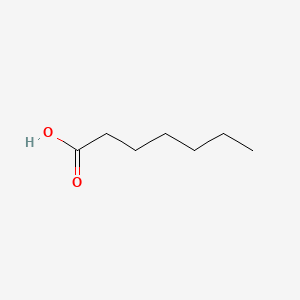| MeSH term | MeSH ID | Detail |
|---|---|---|
| Olfaction Disorders | D000857 | 17 associated lipids |
| Byssinosis | D002095 | 11 associated lipids |
| Mitochondrial Diseases | D028361 | 25 associated lipids |
HEPTANOIC ACID
HEPTANOIC ACID is a lipid of Fatty Acyls (FA) class. Heptanoic acid is associated with abnormalities such as Dehydration. The involved functions are known as Process, Anabolism, inhibitors, Oxidation and fatty acid oxidation. The related lipids are Heptanoates and undecanoic acid.
Cross Reference
Introduction
To understand associated biological information of HEPTANOIC ACID, we collected biological information of abnormalities, associated pathways, cellular/molecular locations, biological functions, related genes/proteins, lipids and common seen animal/experimental models with organized paragraphs from literatures.
What diseases are associated with HEPTANOIC ACID?
HEPTANOIC ACID is suspected in Dehydration and other diseases in descending order of the highest number of associated sentences.
Related references are mostly published in these journals:
| Disease | Cross reference | Weighted score | Related literature |
|---|
Possible diseases from mapped MeSH terms on references
We collected disease MeSH terms mapped to the references associated with HEPTANOIC ACID
PubChem Associated disorders and diseases
What pathways are associated with HEPTANOIC ACID
There are no associated biomedical information in the current reference collection.
PubChem Biomolecular Interactions and Pathways
Link to PubChem Biomolecular Interactions and PathwaysWhat cellular locations are associated with HEPTANOIC ACID?
There are no associated biomedical information in the current reference collection.
What functions are associated with HEPTANOIC ACID?
Related references are published most in these journals:
| Function | Cross reference | Weighted score | Related literatures |
|---|
What lipids are associated with HEPTANOIC ACID?
Related references are published most in these journals:
| Lipid concept | Cross reference | Weighted score | Related literatures |
|---|
What genes are associated with HEPTANOIC ACID?
There are no associated biomedical information in the current reference collection.
What common seen animal models are associated with HEPTANOIC ACID?
There are no associated biomedical information in the current reference collection.
NCBI Entrez Crosslinks
All references with HEPTANOIC ACID
Download all related citations| Authors | Title | Published | Journal | PubMed Link |
|---|---|---|---|---|
| Aminsharifi A et al. | Preventive role of exogenous testosterone on cisplatin-induced gonadal toxicity: an experimental placebo-controlled prospective trial. | 2010 | Fertil. Steril. | pmid:19362306 |
| Chaghi R et al. | Competitive interactions between components in surfactant-cosurfactant-additive systems. | 2010 | J Colloid Interface Sci | pmid:20110091 |
| Thrash JC et al. | Description of the novel perchlorate-reducing bacteria Dechlorobacter hydrogenophilus gen. nov., sp. nov.and Propionivibrio militaris, sp. nov. | 2010 | Appl. Microbiol. Biotechnol. | pmid:19921177 |
| Ahmad Tajidi NS et al. | Diaqua-(1,4,8,11-tetra-aza-cyclo-tetra-decane-κN,N,N,N)copper(II) dihepta-noate dihydrate. | 2010 | Acta Crystallogr Sect E Struct Rep Online | pmid:21588132 |
| Gu L et al. | Parenteral and enteral metabolism of anaplerotic triheptanoin in normal rats. II. Effects on lipolysis, glucose production, and liver acyl-CoA profile. | 2010 | Am. J. Physiol. Endocrinol. Metab. | pmid:19903863 |
| Coen PM et al. | Insulin resistance is associated with higher intramyocellular triglycerides in type I but not type II myocytes concomitant with higher ceramide content. | 2010 | Diabetes | pmid:19833891 |
| Citrome L et al. | Treatment of schizophrenia with depot preparations of fluphenazine, haloperidol, and risperidone among inpatients at state-operated psychiatric facilities. | 2010 | Schizophr. Res. | pmid:20347267 |
| Pedernera-Romano C et al. | Effect of perphenazine enanthate on open-field test behaviour and stress-induced hyperthermia in domestic sheep. | 2010 | Pharmacol. Biochem. Behav. | pmid:19799930 |
| Gunschera J et al. | Surface-catalysed reactions on pollutant-removing building products for indoor use. | 2009 | Chemosphere | pmid:19181362 |
| Reyes-Moreno M et al. | Synthesis and anabolic/androgenic evaluation of novel 9alpha-fluorosteroids. | 2009 | Eur J Med Chem | pmid:19615789 |
| Fuerst M et al. | Articular cartilage mineralization in osteoarthritis of the hip. | 2009 | BMC Musculoskelet Disord | pmid:20038300 |
| Citrome L | Patient perspectives in the development and use of long-acting antipsychotics in schizophrenia: focus on olanzapine long-acting injection. | 2009 | Patient Prefer Adherence | pmid:20016798 |
| Yarali A et al. | Odour intensity learning in fruit flies. | 2009 | Proc. Biol. Sci. | pmid:19586944 |
| Selcho M et al. | The role of dopamine in Drosophila larval classical olfactory conditioning. | 2009 | PLoS ONE | pmid:19521527 |
| Chen CN et al. | A probable aculeacin A acylase from the Ralstonia solanacearum GMI1000 is N-acyl-homoserine lactone acylase with quorum-quenching activity. | 2009 | BMC Microbiol. | pmid:19426552 |
| Le Leu RK et al. | Effect of high amylose maize starches on colonic fermentation and apoptotic response to DNA-damage in the colon of rats. | 2009 | Nutr Metab (Lond) | pmid:19267935 |
| Serra O et al. | Silencing of StKCS6 in potato periderm leads to reduced chain lengths of suberin and wax compounds and increased peridermal transpiration. | 2009 | J. Exp. Bot. | pmid:19112170 |
| Spring S et al. | The photosynthetic apparatus and its regulation in the aerobic gammaproteobacterium Congregibacter litoralis gen. nov., sp. nov. | 2009 | PLoS ONE | pmid:19287491 |
| Titus SA et al. | A new homogeneous high-throughput screening assay for profiling compound activity on the human ether-a-go-go-related gene channel. | 2009 | Anal. Biochem. | pmid:19583963 |
| Bignetti E et al. | The amelioration of olfactory acuity upon sexual maturation might affect food preferences. | 2009 | Nutrients | pmid:22253964 |
